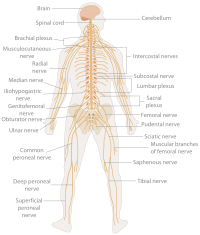
Photo from wikipedia
Endothelial cells (ECs) have gained an increased scientific focus since they were reported to provide guidance for Schwann cells and subsequently following axons after nerve injuries. However, previous protocols for… Click to show full abstract
Endothelial cells (ECs) have gained an increased scientific focus since they were reported to provide guidance for Schwann cells and subsequently following axons after nerve injuries. However, previous protocols for the isolation of nerve-derived ECs from human nerves are ineffective regarding time and yield. Therefore, we established a novel and efficient protocol for the isolation of ECs from human peripheral nerves by means of immunomagnetic CD31-antibody conjugated Dynabeads and assessed the purity of the isolated cells. The easy-to-follow and time-effective isolation method allows the isolation of > 95% pure ECs. The isolated ECs were shown to express highly specific EC marker proteins and revealed functional properties by formation of CD31 and VE-cadherin positive adherens junctions, as well as ZO-1 positive tight-junctions. Moreover, the formation of capillary EC-tubes was observed in-vitro. The novel protocol for the isolation of human nerve-derived ECs allows and simplifies the usage of ECs in research of the human blood-nerve-barrier and peripheral nerve regeneration. Additionally, a potential experimental application of patient-derived nerve ECs in the in-vitro vascularization of artificial nerve grafts is feasible.
Journal Title: Scientific Reports
Year Published: 2021
Link to full text (if available)
Share on Social Media: Sign Up to like & get
recommendations!